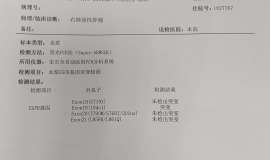ж‘ҳиҰҒпјҡиҝҷ3еҗҚжӮЈиҖ…еңЁеҸ–еҫ—зЁіе®ҡзҡ„еҲҶеӯҗеӯҰзј“и§Јд№ӢеҗҺпјҲиһҚеҗҲеҹәеӣ иҪ¬йҳҙPCRUпјүеҒңз”ЁиҫҫжІҷжӣҝе°јгҖӮ1еҗҚжӮЈиҖ…еӨҚеҸ‘пјҢеҸҰеӨ–дёӨеҗҚжӮЈиҖ…еңЁ1е№ҙеҗҺд»ҚдҝқжҢҒдәҶPCRUгҖӮд»ҘеүҚиҜҙиҝҮпјҢиҫҫжІҷжӣҝе°јзЎ®е®һеҸҜд»ҘжҸҗй«ҳе…Қз–«еҠӣпјҢеёҢжңӣд»ҠеҗҺиғҪиҺ·еҫ—жӣҙеӨҡзҡ„зӣёе…із ”究жҠҘе‘ҠгҖӮ, R2 p, d7 b/ r( `
е…ідәҺиҝҷдёӘз ”з©¶еҖјеҫ—жіЁж„Ҹзҡ„жҳҜпјҢиҝҷдёүеҗҚжӮЈиҖ…йғҪжҳҜжңҚз”Ёж јеҲ—еҚ«еӨұиҙҘеҗҺиҪ¬з”ЁиҫҫжІҷжӣҝе°јзҡ„пјҢд№ҹеҚід»–们еҜ№ж јеҲ—еҚ«жҳҜиҖҗиҚҜзҡ„гҖӮиҝҷдёҺжі•еӣҪзҡ„ж јеҲ—еҚ«еҒңиҚҜз ”з©¶еҸҲжңүжүҖдёҚеҗҢпјҢйӮЈдёӘз ”з©¶дёӯзҡ„жӮЈиҖ…йғҪжҳҜеҜ№ж јеҲ—еҚ«еҸҚеә”иүҜеҘҪзҡ„гҖӮеёҢжңӣеҢ»з”ҹ们иғҪжү©еӨ§з ”究й•ҝжңҹи§ӮеҜҹпјҢзңӢзңӢеҒңз”ЁиҫҫжІҷжӣҝе°јжҳҜеҗҰиғҪжҢҒд№…дёҚеӨҚеҸ‘гҖӮ( I* H$ q! M9 X
0 [1 l# h0 j: p& I s7 @
дҪңиҖ…пјҡжқҘиҮӘжҫіеӨ§еҲ©дәҡ
# v; P( ?; C0 G. c( y6 t* KжқҘжәҗпјҡHaematologica. 2011.8.9.
8 z4 Z# {( i/ j) C1 |1 jDear Group,
0 W9 v. E; n0 O. h" }+ ~
2 i/ r. [1 F3 w$ h1 ?+ |7 ?Some of you are on Dasatinib (Sprycel) and we wish to give news on all CML7 }' z4 q1 C0 B/ g1 O5 ]6 B
therapies. Here is a report from Australia on 3 patients who went off Sprycel- l5 N( B4 m- t7 F* u9 u
after stable molecular response (PCRU). 1 patient relapsed but 2/3 patients
" c' T- }1 G, Dremain in stable PCRU at the 1 year mark. Some of you may remember that Sprycel, q: ^. L0 c4 W
does spike up the immune system so I hope more reports come out on this issue.% f5 [5 H$ y' X
`* r* s' T& A* F8 K% P% I/ ^The remarkable news about Sprycel cessation is that all 3 patients had failed
. Q1 u* c- ?# A- o3 t# KGleevec and Sprycel was their second TKI so they had resistant disease. This is
1 ? O6 \$ Y& f7 M# P5 h1 udifferent from the stopping Gleevec trial in France which only targets patients
6 J$ F! e8 P6 Fwho have done well on Gleevec.
( t1 U0 Y4 F9 Z$ {" E a
5 Z9 m5 Z* |* iHopefully, the doctors will report on a larger study and long-term to see if the
7 v' y9 q' v* h$ m9 a4 rresponse off Sprycel is sustained.
. b4 |& {9 L/ g% X1 _4 g
. D" c1 i4 t4 Q$ A! HBest Wishes,
0 \5 s) ~* F2 UAnjana
0 ~. s9 F1 E+ G9 k! ^) ^* u/ M2 i* J, u: U5 s3 e1 A
6 m; y/ t* [. d1 t- O
# s9 ~* {7 U' |* |Haematologica. 2011 Aug 9. [Epub ahead of print]# ~! |/ Q2 x; I, b9 R
Durable complete molecular remission of chronic myeloid leukemia following( n1 h! d. h) u1 n5 E
dasatinib cessation, despite adverse disease features.8 F5 h3 s( K) V; q
Ross DM, Bartley PA, Goyne J, Morley AA, Seymour JF, Grigg AP.
* I! z! @) z( e/ e6 RSource
" d3 h! q8 g9 Z' D4 }Adelaide, Australia;: K5 G0 B! r* `. n
8 _7 [$ g6 v& O$ AAbstract6 W, Y. q! i3 a8 j6 ~4 O
Patients with chronic myeloid leukemia, treated with imatinib, who have a
' f) J9 W- H3 c4 @7 f/ ]' e/ Z! ]' Idurable complete molecular response might remain in CMR after stopping( L! z/ W4 Z$ X! o' i
treatment. Previous reports of patients stopping treatment in complete molecular
7 O# z6 f0 P- y7 E' s3 nresponse have included only patients with a good response to imatinib. We
- O7 \0 n8 w# u4 [/ Zdescribe three patients with stable complete molecular response on dasatinib r' Y; T/ z; Z) J- ]1 c
treatment following imatinib failure. Two of the three patients remain in
3 x" d, V1 P C& y& Y' e' ycomplete molecular response more than 12 months after stopping dasatinib. In; r7 T" B4 w0 F4 v
these two patients we used highly sensitive patient-specific BCR-ABL1 DNA PCR to$ g7 u+ W' y/ |; ^$ Y/ d+ E* U3 Y Z% k
show that the leukemic clone remains detectable, as we have previously shown in! `* ~3 d3 u7 U# _; V
imatinib-treated patients. Dasatinib-associated immunological phenomena, such as8 F J8 X) E6 Q* |
the emergence of clonal T cell populations, were observed both in one patient, F* }$ X# w9 h- K `/ i
who relapsed and in one patient in remission. Our results suggest that the) d3 x8 v; K! I, l# ^- e
characteristics of complete molecular response on dasatinib treatment may be! q6 [) j, E p& K" e7 l3 m
similar to that achieved with imatinib, at least in patients with adverse
3 V& O& M) o! l) |disease features./ f0 A& b, d5 J- u9 f4 Y
|


